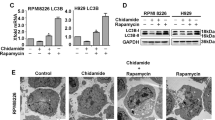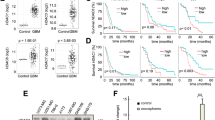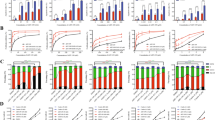Abstract
This study found that MS-275, a novel synthetic benzamide histone deacetylase inhibitor (HDACI), blocked Akt/mammalian target of rapamycin (mTOR) signaling in acute myelogenous leukemia (AML) HL60 and acute promyelocytic leukemia (APL) NB4 cells, as assessed by decreased levels of the phosphorylated (p)-Akt, p-p70 ribosomal S6 kinase (p70S6K) and p-S6K by western blot analysis. Interestingly, further inactivation of mTOR by rapamycin analog RAD001 (everolimus) significantly enhanced MS-275-mediated growth inhibition and apoptosis of these cells in parallel with enhanced upregulation of p27kip1 and downregulation of c-Myc. In addition, RAD001 potentiated the ability of MS-275 to induce differentiation of HL60 and NB4 cells, as measured by the expression of CD11b cell surface antigens, as well as reduction of nitroblue tetrazolium. Importantly, RAD001 potentiated the ability of MS-275 to induce the expression of the myeloid differentiation-related transcription factor, CCAAT enhancer-binding protein-ɛ, in these cells in association with enhanced acetylation of histone H3 on its promoter. Furthermore, RAD001 (5 mg/kg) significantly enhanced the effects of MS-275 (10 mg/kg) to inhibit proliferation of HL60 tumor xenografts in nude mice without adverse effects. Taken together, concomitant administration of an HDACI and an mTOR inhibitor may be a promising treatment strategy for the individuals with a subset of human leukemia.
This is a preview of subscription content, access via your institution
Access options
Subscribe to this journal
Receive 12 print issues and online access
$259.00 per year
only $21.58 per issue
Buy this article
- Purchase on Springer Link
- Instant access to full article PDF
Prices may be subject to local taxes which are calculated during checkout








Similar content being viewed by others
References
Lowenberg B, Downing JR, Burnet A . Acute myeloid leukemia. N Engl J Med 1999; 341: 1051–1062.
Wolff SN, Herzig RH, Fay JW, LeMaistre CF, Brown RA, Frei-Lahr D et al. High-dose cytarabine and daunorubicin as consolidation therapy for acute myeloid leukemia in first remission: long-term follow-up and results. J Clin Oncol 1989; 7: 1260–1267.
Wells RJ, Woods WG, Buckley JD, Odom LF, Benjamin D, Bernstein I et al. Treatment of newly diagnosed children and adolescents with acute myeloid leukemia: a Childrens Cancer Group study. J Clin Oncol 1994; 12: 2367–2377.
Harousseau JL, Cahn JY, Pignon B, Witz F, Milpied N, Delain M et al. Comparison of autologous bone marrow transplantation and intensive chemotherapy as postremission therapy in adult acute myeloid leukemia. Blood 1997; 90: 2978–2986.
Schlenk RF, Döhner K, Krauter J, Fröhling S, Corbacioglu A, Bullinger L et al. German-Austrian Acute Myeloid Leukemia Study Group. Mutations and treatment outcome in cytogenetically normal acute myeloid leukemia. N Engl J Med 2008; 358: 1909–1918.
Minucci S, Pelicci PG . Histone deacetylase inhibitors and the promise of epigenetic (and more) treatments for cancer. Nat Rev Cancer 2006; 6: 38–51.
Sakajiri S, Kumagai T, Kawamata N, Saitoh T, Said JW, Koeffler HP . Histone deacetylase inhibitors profoundly decrease proliferation of human lymphoid cancer cell lines. Exp Hematol 2005; 33: 53–61.
Nishioka C, Ikezoe T, Yang J, Komatsu N, Bandobashi K, Taniguchi A et al. Histone deacetylase inhibitors induce growth arrest and apoptosis of HTLV-1-infected T-cells via blockade of signaling by nuclear factor kappaB. Leuk Res 2008; 32: 287–296.
Grignani F, De Matteis S, Nervi C, Tomassoni L, Gelmetti V, Cioce M et al. Fusion proteins of the retinoic acid receptor-α recruit histone deacetylase in promyelocytic leukaemia. Nature 1998; 391: 815–818.
Grunstein M . Histone acetylation in chromatin structure and transcription. Nature 1997; 389: 349–352.
He LZ, Tolentino T, Grayson P, Zhong S, Warrell Jr RP, Rifkind RA et al. Histone deacetylase inhibitors induce remission in transgenic models of therapy-resistant acute promyelocytic leukemia. J Clin Invest 2001; 108: 1321–1330.
Gottlicher M, Minucci S, Zhu P, Krämer OH, Schimpf A, Giavara S et al. Valproic acid defines a novel class of HDAC inhibitors inducing differentiation of transformed cells. EMBO J 2001; 20: 6969–6978.
Kuendgen A, Gattermann N . Valproic acid for the treatment of myeloid malignancies. Cancer 2007; 110: 943–954.
Lekstrom-Himes J, Xanthopoulos KG . Biological role of the CCAAT/enhancer-binding protein family of transcription factors. J Biol Chem 1998; 273: 28545–28548.
Chumakov AM, Grillier I, Chumakova E, Chih D, Slater J, Koeffler HP . Cloning of the novel human myeloid-cell-specific C/EBP-epsilon transcription factor. Mol Cell Biol 1997; 17: 1375–1386.
Morosetti R, Park DJ, Chumakov AM, Grillier I, Shiohara M, Gombart AF et al. A novel, myeloid transcription factor, C/EBP epsilon, is upregulated during granulocytic, but not monocytic, differentiation. Blood 1997; 90: 2591–2600.
Yamanaka R, Barlow C, Lekstrom-Himes J, Liu PP, Eckhaus M, Decker T et al. Impaired granulopoiesis, myelodysplasia, and early lethality in CCAAT/enhancer binding protein epsilon-deficient mice. Proc Natl Acad Sci USA 1997; 94: 13187–13192.
Nakajima H, Watanabe N, Shibata F, Kitamura T, Ikeda Y, Handa M . N-terminal region of CCAAT/enhancer-binding protein epsilon is critical for cell cycle arrest, apoptosis, and functional maturation during myeloid differentiation. J Biol Chem 2006; 281: 14494–14502.
Gery S, Gombart AF, Fung YK, Koeffler HP . C/EBPepsilon interacts with retinoblastoma and E2F1 during granulopoiesis. Blood 2004; 103: 828–835.
Bjornsti MA, Houghton PJ . Lost in translation: dysregulation of cap-dependent translation and cancer. Cancer Cell 2004; 5: 519–523.
Hay N, Sonenberg N . Upstream and downstream of mTOR. Genes Dev 2004; 18: 1926–1945.
Yee KW, Zeng Z, Konopleva M, Verstovsek S, Ravandi F, Ferrajoli A et al. Phase I/II study of the mammalian target of rapamycin inhibitor everolimus (RAD001) in patients with relapsed or refractory hematologic malignancies. Clin Cancer Res 2006; 12: 5165–5173.
Nishioka C, Ikezoe T, Yang J, Koeffler HP, Taguchi H . Fludarabine induces apoptosis of human T-cell leukemia virus type 1-infected T cells via inhibition of the nuclear factor-kappaB signal pathway. Leukemia 2007; 21: 1044–1049.
Ikezoe T, Nishioka C, Tasaka T, Yang Y, Komatsu N, Togitani K et al. The antitumor effects of sunitinib (formerly SU11248) against a variety of human hematologic malignancies: enhancement of growth inhibition via inhibition of mammalian target of rapamycin signaling. Mol Cancer Ther 2006; 5: 2522–2530.
Nishioka C, Ikezoe T, Takeshita A, Yang J, Tasaka T, Yang Y et al. ZD6474 induces growth arrest and apoptosis of human leukemia cells, which is enhanced by concomitant use of a novel MEK inhibitor, AZD6244. Leukemia 2007; 21: 1308–1310.
Ikezoe T, Daar ES, Hisatake J, Taguchi H, Koeffler HP . HIV-1 protease inhibitors decrease proliferation and induce differentiation of human myelocytic leukemia cells. Blood 2000; 96: 3553–3559.
Ikezoe T, Hisatake Y, Takeuchi T, Ohtsuki Y, Yang Y, Said JW et al. HIV-1 protease inhibitor, ritonavir: a potent inhibitor of CYP3A4, enhanced the anticancer effects of docetaxel in androgen-independent prostate cancer cells in vitro and in vivo. Cancer Res 2004; 64: 7426–7431.
Nishioka C, Ikezoe T, Yang J, Koeffler HP, Yokoyama A . Inhibition of MEK/ERK signaling synergistically potentiates histone deacetylase inhibitor-induced growth arrest, apoptosis and acetylation of histone H3 on p21(waf1) promoter in acute myelogenous leukemia cell. Leukemia 2008; 22: 1449–1452.
Ikezoe T, Tanosaki S, Krug U, Liu B, Cohen P, Taguchi H et al. Insulin-like growth factor binding protein-3 antagonizes the effects of retinoids in myeloid leukemia cells. Blood 2004; 104: 237–242.
Nagaki K, Talbert PB, Zhong CX, Dawe RK, Henikoff S, Jiang J . Chromatin immunoprecipitation reveals that the 180-bp satellite repeat is the key functional DNA element of Arabidopsis thaliana centromeres. Genetics 2003; 163: 1221–1225.
Rosato RR, Almenara JA, Grant S . The histone deacetylase inhibitor MS-275 promotes differentiation or apoptosis in human leukemia cells through a process regulated by generation of reactive oxygen species and induction of p21CIP1/WAF1 1. Cancer Res 2003; 63: 3637–3645.
Lucas DM, Davis ME, Parthun MR, Mone AP, Kitada S, Cunningham KD et al. The histone deacetylase inhibitor MS-275 induces caspase-dependent apoptosis in B-cell chronic lymphocytic leukemia cells. Leukemia 2004; 18: 1207–1214.
Kawamata N, Chen J, Koeffler HP . Suberoylanilide hydroxamic acid (SAHA; vorinostat) suppresses translation of cyclin D1 in mantle cell lymphoma cells. Blood 2007; 110: 2667–2673.
Chen CS, Weng SC, Tseng PH, Lin HP, Chen CS . Histone acetylation-independent effect of histone deacetylase inhibitors on Akt through the reshuffling of protein phosphatase 1 complexes. J Biol Chem 2005; 280: 38879–38887.
Ishida S, Shigemoto-Mogami Y, Shinozaki Y, Kagechika H, Shudo K, Ozawa S et al. Differential modulation of PI3-kinase/Akt pathway during all-trans retinoic acid- and Am80-induced HL-60 cell differentiation revealed by DNA microarray analysis. Biochem Pharmacol 2004; 68: 2177–2186.
Ozpolat B, Akar U, Steiner M, Zorrilla-Calancha I, Tirado-Gomez M, Colburn N et al. Programmed cell death-4 tumor suppressor protein contributes to retinoic acid-induced terminal granulocytic differentiation of human myeloid leukemia cells. Mol Cancer Res 2007; 5: 95–108.
Gery S, Park DJ, Vuong PT, Virk RK, Muller CI, Hofmann WK et al. RTP801 is a novel retinoic acid-responsive gene associated with myeloid differentiation. Exp Hematol 2007; 35: 572–578.
Corradetti MN, Inoki K, Guan KL . The stress-inducted proteins RTP801 and RTP801L are negative regulators of the mammalian target of rapamycin pathway. J Biol Chem 2005; 280: 9769–9772.
Acknowledgements
This work was supported in part by Kanae Foundation for the Promotion of Medical Science and the Fund for Academic Research from Kochi University. HPK is supported by NIH grants, as well as, the Sheryl Weissberg Lymphoma Foundation and the Parker Hughes Trust.
CN is grateful for a JSPS Research Fellowship for Young Scientists from the Japan Society for the Promotion of Science. Author contribution: Takayuki Ikezoe contributed to the concept and design, interpreted and analyzed the data and wrote the article. Chie Nishioka performed the experiments and wrote the article. Jing Yang performed the experiments. H Phillip Koeffler provided critical revision and intellectual content. Akihito Yokoyama provided important intellectual content and gave final approval.
Author information
Authors and Affiliations
Corresponding author
Additional information
Conflict of interest
The authors declare no competitive financial interests.
Rights and permissions
About this article
Cite this article
Nishioka, C., Ikezoe, T., Yang, J. et al. Blockade of mTOR signaling potentiates the ability of histone deacetylase inhibitor to induce growth arrest and differentiation of acute myelogenous leukemia cells. Leukemia 22, 2159–2168 (2008). https://doi.org/10.1038/leu.2008.243
Received:
Revised:
Accepted:
Published:
Issue Date:
DOI: https://doi.org/10.1038/leu.2008.243
Keywords
This article is cited by
-
Metabolomics Reveals that Cysteine Metabolism Plays a Role in Celastrol-Induced Mitochondrial Apoptosis in HL-60 and NB-4 Cells
Scientific Reports (2020)
-
NTAL is associated with treatment outcome, cell proliferation and differentiation in acute promyelocytic leukemia
Scientific Reports (2020)
-
LRRC25 plays a key role in all-trans retinoic acid-induced granulocytic differentiation as a novel potential leukocyte differentiation antigen
Protein & Cell (2018)
-
PLSCR1/IP3R1/Ca2+ axis contributes to differentiation of primary AML cells induced by wogonoside
Cell Death & Disease (2017)
-
Anti-CD44 antibodies inhibit both mTORC1 and mTORC2: a new rationale supporting CD44-induced AML differentiation therapy
Leukemia (2016)



